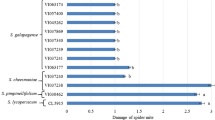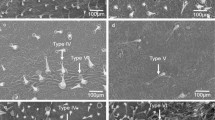Abstract
Zingiberene, a sesquiterpene present in glandular trichomes of Lycopersicon hirsutum Dunal var. hirsutum ‘PI-127826’, is responsible for the high level of arthropod resistance in this taxon. The current paper has the following objectives: (a) to quantify zingiberene content in tomato plants obtained from the interspecific cross L. esculentum Mill. × L. hirsutum var hirsutum; (b) to identify, classify and quantify glandular and non-glandular trichome types present in those plants; (c) to assess the level of resistance of those genotypes to spider mites (Tetranychus evansi); (d) to estimate correlations between glandular trichomes, zingiberene contents and mite repellence. Zingiberene content were quantified by a colorimetric method (Freitas, 1999); trichomes were counted from foliar paradermic slide preparations; mite resistance was assessed by a repellence test (Weston & Snyder, 1990). The results indicate that indirect selection for zingiberene content led to correlated increases both in the number of glandular trichomes (particulary type IV) and in the levels of mite repellence. These results were found both in BPX-368 [=F2 (L. esculentum ‘TOM-556’ × L hirsutum var. hirsutum ‘PI-127826’)] and in the subsequent generation BPX-368B (which represents one additional backcross to L.esculentum). Zingiberene appears therefore to be the main factor involved in mite repellence. Density of glandular trichomes in tomato leaflets markedly influences total zingiberene content. Type IV trichome density was the highest, and it was highly correlated to zingiberene content.
Similar content being viewed by others
References
Azevedo, S.M., W.R. Maluf, M.V. Faria, A.C.B. Oliveira, C.A. Ribeiro, R.C. Gonçalves-Gervasio & L.V.C. Santa-Cecília, 1999. Resistência à traça (Tuta absoluta) em genótipos de tomateiro com diferentes teores de sesquiterpenos nos folíolos. Horticultura brasileira 17: 273.
Carter, C.D. & J.C. Snyder, 1985. Miteresponses in relation to trichomes of Lycopersicon esculentum x L. hirsutum F2 hibrids. Euphytica 34: 177–185.
Carter, C.D., J.N. Sacalis & T.J. Gianfagna, 1989. Zingiberene and resistence to Colorado Potato Beetle inLycopersicon hirsutum f. hirsutum. J Agric Food Chem 37: 206–210.
Carter, C.D., J.N. Sacalis & T.J. Gianfagna, 1988. Resistence to Colorado Potato Bettle in relation to zingiberene content of Lycopersicon species. Rep Tomato Genet Coop 38: 11–12.
Channarayappa, G., V. Mumiyappa & R.M. Frist, 1992.Resistance of Lycopersicon species to Bemisia tabaci, a tomato leal curl virus vector. Can J Bot 70: 2184–2192.
Eigenbrode, S.D. & J.T. Trumble, 1993. Antibiosis to beet armyworm (Spodoptera exigua) in Lycopersicon accessions. Hort Sci 28: 932–934.
Eigenbrode, S.D., J.T. Trumble, J.G. Millar & K.K. White, 1994.Topical toxicity of tomato sesquiterpenes to the beet armyworm and the role of these compounds in resistance derived from an accession of Lycopersicon hirsutum f. typicum. J Agric & Food Chem 42: 807–810.
Fery, R.L. & G.G. Kennedy, 1987. Genetic analysis of 2-tridecanone concentration, leaf trichome characteristics and tobacco hornworm. resistance in tomato. J Amer Soc Hort Sci 112: 886–891.
França, F.H., W.R. Maluf, P.E.F. Rossi, J.E.C. Miranda & M.C.F. Coelho, 1984. Avaliação e seleção em tomate visando resistência à traça-do-tomateiro. In: Congresso Brasileiro de Olericultura, 24. Res Jaboticabal, SOB, Brazil. p. 143. (Abstract)
Freitas, J.A.,1999. Resistência genética de tomateiro Lycopersicon spp. à mosca branca Bemisia spp. mediada por zingibereno contido em tricomas glandulares. Lavras, Universidade Federal de Lavras, Brazil. 93 p. (Doctoral Thesis).
Gentile, A.G., R. Webb & A.K. Stoner, 1969. Lycopersicon and Solanum resistant to the carmine and the two-spotted spider mite. J Econ Entom 62: 834–836.
Gianfagna, T.J., C.D. Carter & J.N. Sacalis, 1992. Temperature and photoperiodinfluence trichome density and sesquiterpene content of Lycopersicon hirsutum f. hirsutum. Pl Physiol 100: 1403–1405.
Goffreda, J.C., M.A. Mutschler, D.A. Ave, W.M. Tingey & J.C. Steffens, 1989. Aphid deterrence by glucoseesters in glandular trichome exudate of wild tomato Lycopersicon pennellii. J Chem Ecol 15: 2135–2147.
Gonçalves, M.I.F., W.R. Maluf, L.A.A. Gomes & L.V. Barbosa, 1998. Variation of 2-tridecanone level in tomatoplant leaflets and resistance to two mite species (Tetranychus sp.). Euphytica 104: 33–38.
Guo, Z., P.A. Weston & J.C. Snyder, 1993. Repellency to twospotted spider mite Tetranychus urticae Koch, as related to leaf surface chemistry of Lycopersicon hirsutum accessions. J Chem Ecol 19: 2965–2979.
Jensen, W.A., 1962. BotanicalHistochemistry: Principles and Practice. San Francisco, W.H. Freeman Co., 40 pp.
Juvik, J.A., M.J. Berlinger, T. Ben-David, J. Rudich, 1982. Resistance among accessions of genera Lycopersicon and Solanum to four of the main insects pests of tomato in Israel. Phytoparasitica 10: 145–156.
Labourian, L.G., J.G. Oliveira & M.L. Salgado-Labourian,1961. Transpiração de Schizolobium parahyba (VELL.) Toledo. I. Comportamento na estação chuvosa, nas condições de Caeté, Minas Gerais, Brasil. Anais da Academia Brasileira de Ciências 33: 237–257.
Luckwill, L.C., 1943.The Genus Lycopersicon: A Historical, Biological and Taxonomic Survey of Wild and Cultivated Tomatoes. Aberdeen, Aberdeen University Press, n. 120. 44 pp.
Maluf, W.R., L.V. Barbosa & L.V. Costa Santa-Cecília,1997. 2-Tridecanone-mediated mechanisms of resistance to the South American tomato pinworm Scrobipalpuloides absoluta (Meyrick, 1917) (Lepidoptera-Gelechiidae) in Lycopersicon spp. Euphytica 93: 189–194.
Rick, C.M., 1973.Potential genetic resources in tomato species: clues from observations in native habitats. In: A.M. SRB (Ed.), Genes, Enzymes and Populations, pp. 255–259. Plenum Press, New York.
Silverstein, R.M., G.C. Bassler & T.C. Morrill, 1994. Identificação espectrométrica de compostos orgânicos. 5a ed. Rio de Janeiro, Koogan, 387 pp.
Snyder, J.C. & C.D. Carter, 1985. Trichomes on leaves of Lycopersicon hirsutum and L. esculentum and theirhybrids. Euphytica 34: 53–64.
Snyder, J.C. & J.P. Hyatt, 1984. Influences of daylength on trichomedensities and leaf volatiles of Lycopersicon species. Plant Sci Letters 37: 177–181.
Snyder, J.C., D.A. Johnson, D.E. Good & P.A. Weston, 1987. Type VI trichome exsudates from genotypes of L. hirsutum f. glabratum. Rep Tomato Genet Coop 37: 67–68.
Weston, P.A. & J.C. Snyder, 1990 Thumbtack bioassay: a quick method ofmeasuring plant resistance to two-spotted spider mites (Acari: Tetranychidae). J Econ Entom 83(2): 501–504.
Weston, P.A., A.D. Johnson, H.T. Burton & J.C. Snyder, 1989. Trichome secretion composition, trichome densities,and spider mite resistance of ten accessions of Lycopersicon hirsutum. J Amer Soc Hort Sci 114: 492–498.
Williams, W.G., G.G. Kennedy, E.T. Yamamoto, J.D. Thacker & J. Borner, 1980. 2-Tridecanone - a naturallyoccurring insecticide from the wild tomato Lycopersicon hirsutum f. glabratum. Science 207: 888–889.
Author information
Authors and Affiliations
Additional information
Graduate Student;
Rights and permissions
About this article
Cite this article
Maluf, W.R., Campos, G.A. & das Graças Cardoso, M. Relationships between trichome types and spider mite (Tetranychus evansi) repellence in tomatoes with respect to foliar zingiberene contents. Euphytica 121, 73–80 (2001). https://doi.org/10.1023/A:1012067505361
Issue Date:
DOI: https://doi.org/10.1023/A:1012067505361




